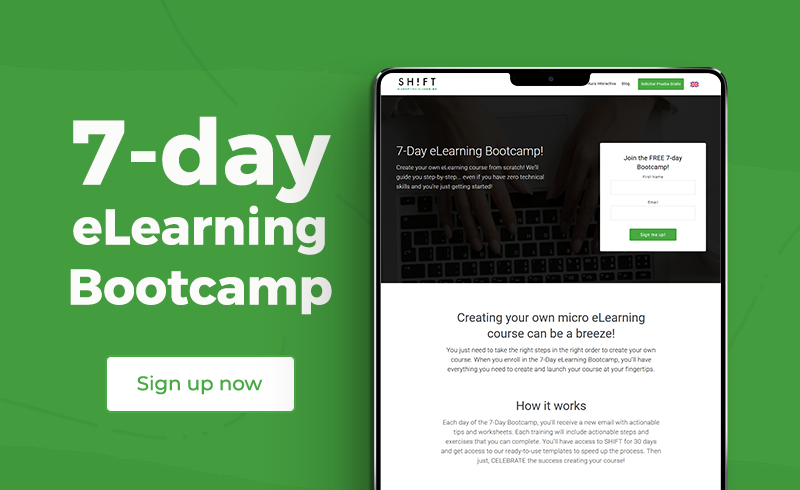Learning leaders, you have lessons to learn from the marketing pros. More specifically, you need to learn a tip or two on “branding.”
If you thought branding is something that only FMCG manufacturers, car dealers, and luxury watch sellers need to practice, think again.
With a pressing need to keep employees on top of industry knowledge and skills, you MUST ensure that your eLearning courses do not get lost in the crowd. You MUST make your courses visible. Else, your efforts go to waste. Or worse, your learners waste energy hunting around for content or learn inadequately.
In a “noisy” world, branding ensures learners recognize you as an authority and turn to you when they want to learn.
But branding is also so much more than garnering visibility for your courses and expertise. Read on to find out how branding subtly affects your bottom line in more ways than one.
The Benefits of Branding for Your Corporate eLearning Programs

Branding benefits you, your L&D team, your course offerings, and your company in myriad ways:
- Building a brand is like creating a “team.” A brand identity unites everyone—designers, developers, programmers, artists, writers, SEM's and managers—under a single banner and creates a “team” out of disparate functional groups. When the “team spirit” abounds, people feel motivated to work cohesively towards a common goal. Team spirit encourages cooperation and harmonious relations.
- A brand identity shines the spotlight on the personality of your products. One of the greatest benefits of branding is that you can infuse a personality into your course offerings. People respond more readily and warmly to personalities than simple-plain marketing messages.
- A brand identity is like a stamp of your integrity, ethics, and professionalism. When you have a distinct identity, you strive to uphold the right that your brand stands for. The team works as a whole to keep up this positive image, and others too want to know that you will go the extra mile to preserve your brand identity.
- A brand communicates that you care about your employees. Branding your L&D function sends out the right signals to employees. They feel assured knowing that you care about their professional development and are willing to invest in their skills.
- A brand elicits loyalty. Whether it is your employees who are buoyed by your commitment to their career growth or your team that feels committed to delivering excellence, a brand identity elicits loyalty and support from varied quarters. Building a brand drives growth.
How to Build Your Learning Brand and Make It Work For You
You can present your learning brand in any number of ways, but to make it works for you, you must ensure it is built on the following principles:
1) Leadership Support and Commitment
Leaders are pivotal to the success of the branding initiative. According to multiple studies, learning programs with greater leadership involvement are perceived to be more credible and effective than those where the leaders are less visible.
Here are some ways to increase leadership involvement in the eLearning efforts of an organization:
- Learning developers must frequently collaborate with leaders while designing and developing the programs.
- Learning developers must ensure that the programs align with business goals and bring in results that the senior leadership had envisioned.
- Leaders must invest time, effort, and money in creating a sustainable organizational learning culture.
2) Employees as Brand Ambassadors
There is no better branding tactic than having an engaged and committed employees spread the good word about your organization. Their enthusiasm rubs off on others, and they are motivated to join forces with you or seek you out when they need to learn. They are the most powerful brand assets you have… so use them to your advantage!
Turn your employees into brand ambassadors with the following tactics:
- Create a recognition program for all employees who go above and beyond their expected tasks to spread the voice. Reward your best ambassadors with giveaways, badges or schedule flexibility options.
- Provide ample opportunities for them to grow and advance professionally, learn at the workplace, and enjoy harmonious and mutually fruitful relations with co-workers.
- Make it easy for them. Give them the content you want them to share! For instance, provide them with a suggested small paragraph about the new training program that they can add to their social media profile. Provide them with graphics, photos, hashtags and any type of assets they can use in the different platforms you plan for employees to use.
- Set the rules. Before people start spreading the word about your programs, you need to have a policy or some set of established rules up. This will guide your employees in posting content that is in line with the project's goals and mission.
- Provide them with the social training and tools necessary to reach out to and interact with existing and potential customers of your company.
- Encourage them to provide feedback to you about customers.
Read how Adobe has created brand ambassadors out of employees.
3) Learning Culture Influences Branding
Your brand won’t evoke trust and loyalty if you do not practice what you preach. If you have built a brand for your eLearning program, it is natural that you are expected to exhibit a commitment to spread knowledge and encourage learning. What better way to achieve this than to create an organizational learning culture!
Here’s what to keep in mind when you build a learning culture in your organization:
- Empower your employees by creating a culture of self-directed learning.
- Provide all the tools necessary to help employees seek out resources and take learning into their own hands. Offer mobile learning.
- Create a sustainable learning culture where employees are motivated to learn. Provide them with relevant learning resources, and create workplace schedules where they can fit in training time.
- Show your commitment towards preserving the learning culture you have created.
Finally, take some cues from the Google way of creating a strong learning culture.
4) Purpose
Adult corporate learners are sensible, prudent individuals who value their time and do not want to waste energy on the trivial or the irrelevant. They look for meaning and purpose in everything they do. They search for relevance in every learning program that you ask them to take.
Establish clarity of purpose and relevance of your eLearning programs with the following tips:
- Know your target audience, so you can determine what is relevant to them.
- State the what’s-in-it-for-me information right at the start of the course.
- Reiterate the relevance of what you are teaching throughout the course. This means that you should provide the what’s-in-it-for-me information before beginning every learning module or activity.
- Consider creating an air of anticipation by rolling out teasers before you launch a course. Make sure that the teasers establish the relevance of the upcoming course.
5) Consistency and Recognition are critical pieces of the puzzle
We don’t like our loved ones to change overnight. It is no different with the brands we love; we don’t like them to look different, feel different, or speak differently too often. Familiarity is comforting, and when it comes to brands, consistency aids recognition and gives the impression that they will continue to provide the same top-notch quality of service as before.
When you create your eLearning brand, ensure that you maintain consistency in the following elements:
- Messages: use the same tone always
- Look and feel of the courses
- Logo
- Color scheme
6) Focus on your target audience
The power of your brand relies on the ability to make your audience feel important. That is why knowing your target audience thoroughly will help to build a strong brand.
As an L&D professional, you would want your brand to give rise to such warm and fuzzy feelings in your audience. A brand that stirs such feelings cements its place not only in the minds but also in the hearts of its audience.
Here are some tips on how to let learners know that they are at the center of your learning universe:
- Focus on your audience. All loved brands make it their business to focus on their target audience. Carry out a thorough audience analysis to know who you are serving.
- Create spot-on, relevant courses. This shows that you value your audience’s time, and this is the golden rule of brand-building.
- Speak to your audience in a language that they understand.
- Create a personality for your brand that immediately strikes a chord with your audience. For instance, if your audience comprises young office-goers who love to have fun at the workplace, adopt an informal tone and infuse your brand personality with a casual and relaxed air.
7) Use Emotional Appeal
Nothing resonates more with human beings than emotions. We love to laugh. Tears move us. We are inspired by the success stories crafted by other people. As an L&D developer, you have to make your brand memorable by evoking emotions in your audience. So instead of just focusing on creating courses, you should focus on creating learning experiences that stir emotions in learners.
Your imagination is the limit when it comes to the experience you want to craft for your audience, but keep these pointers in mind to avoid the pitfalls:
- Stick to simplicity. Don’t make life difficult for your audience; they are already drowning in noise. Make sure that your messages are not ambiguous. Ensure that you do not make learners go round in circles with confusing navigation. Choose images wisely, so they complement the text.
- Create a unique personality. Human beings connect emotionally to and relate with another emotive being. Do not hide behind jargons. Instead, create a brand personality that comes across as natural, human, and compassionate. This personality will help you forge bonds with your audience and elicit loyalty. Make sure that the personality you create does not jar the sensibilities of your audience.
- Be social. Your corporate learners appreciate being able to take time off from being all sedate and serious. You will immediately endear yourself to them if you provide them with opportunities to unwind (at the workplace) and let their hair down and socialize (while learning). Think up activities that weave in the “social” component.
- Test your experiences. Test drive the learning experiences before you roll out the courses. This gives you another chance to refine your products and align them with audience needs and expectations.
Your learning brand is a key asset. It is branding that draws your audience towards you. Even before they have clicked through a few slides, your audience perceives your brand and decides if they want to stick around with you. Ensure that you are giving off the right vibes with your branding.
SOURCES:
A Year of Innovative Activities to Market a New Training Team
Introduction to Brand Strategy: 7 Essentials for a Strong Company Brand
Top Takeaways for Branding Your Wellness Benefits and Creating a Great Employee Experience



